Commissioned by Nino Mier Gallery, Los Angeles to accompany Cornelia Baltes' solo exhibition 'Lazy Bones' in 2022.

Installation View of Cornelia Baltes, Lazybones. Nino Mier Gallery, Los Angeles
Reading time 5'
On Diagonal Looking
Cornelia Baltes trades in the diagonal look. This sideways glance betrays an omnivorous curiosity, absorbing the world at slant. The curve of a lapel, knobby knees, the profile of a dusty vase, a new trainer’s sole, flexed muscle: Baltes’ eye is restlessly precise. It scans the environment, translating the incidental into something monumental. Baltes produces images like we consume them, her references are panoramic. Attending to the everyday; she sees and undoes the world by harnessing the peripheral look.
Diagonal looking is messy. Much of what we see in the corner of our eyesight is made up in the mind. Our eyes tend to be much less sensitive in indirect vision and our brains must piece together information from memory and social conditioning to make sense of what we see. These paintings disrupt cognition, messing with the ocular and neurological. The eye and mind start to talk over each other producing productive mistranslations.
Baltes’ paintings refract, simplify, expand, edit, remix, and amplify. Drawing remains central to this transformation, marking out and mutating, mapping and un-mapping. Hints of Ellsworth Kelly and Patrick Caulfield merge with Disney’s visual wit, the elegance of Japanese ink drawing and the slapstick comedy of Buster Keaton. This influence soup is refracted through the chromatic vocabulary of graphic design and commercial imagery.
In linguistics, a homonym is a word that has multiple meanings and these images trade in a similar multivalency: they are painterly homonyms. The painter Frank Auerbach once said: “a great painting is like ice on a stove. It is a shape riding on its own melting into matter and space; it never stops moving backwards and forwards,” and his words resonate here. Putting Auerbach and Baltes into the same text feel incongruous; like comparing chocolate gateau with lemon sorbet. Yet, the quote characterizes the painterly animation that Baltes’ engages with. This iconographic slipperiness — is it a blade of grass or an arm? — mirrors this mobility of the indistinct look. These paintings are invitations to flex the occipital lobe — the part of the brain where sight is processed — and make it sweat.
Of course, Baltes’ work looks simple. But it isn’t. The surfaces, which are as smooth as vinyl, are produced through laborious repainting. The title of the exhibition — Lazybones — coupled with the iconography of the show which riffs on gym imagery, and the less-than-obvious labour seems self-depreciative. As a non-native English speaker, one wonders how Baltes is translating the idiom: does she see a slouching skeleton or a pile of knackered bones? Lazybones is a fairly abstract phrase and is often used interchangeably with bone idle and lazy boots. When taken out of their native context, idioms are ripe for misreading. Unlike math, written and visual language is not an efficient form of communication.
Images that slip in and out of recognition, paintings that look breezy but aren’t, titles that that don’t quite add up. It’s in the space of formal and metaphorical in-betweenness that Baltes’ practice is situated. The title is outlier; don’t believe it: Lazybones is an invitation to accompany the artist in her diagonal looking (and thinking). Start exercising, put that brain to task and make it sweat.